The Schmidt family of Machtlos began with Hans Heinrich Schmidt and Barbara (Rimbach) Schmidt, who lived in the latter 1600s and early 1700s. The branches of the Machtlos Schmidt family who settled in America, however, exist because of Hans Heinrich’s great great grandson: Dietrich Schmidt.
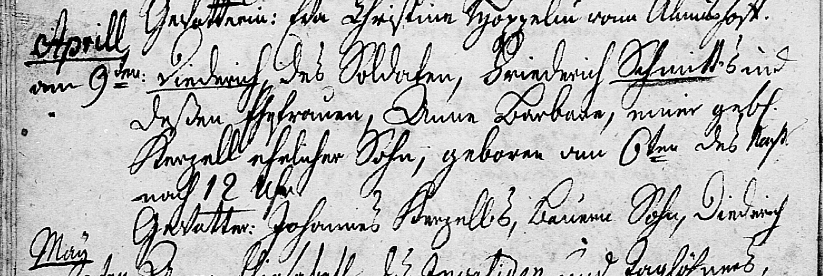 Dietrich Schmidt baptism record, 6 April 1803, Machtlos
Dietrich Schmidt baptism record, 6 April 1803, Machtlos
Dietrich Schmidt was born in the village of Machtlos, Germany, on the cool spring day of April 6th, 1803. He was the son of Johann Friedrich Schmidt (a linen weaver, day laborer, and former musketeer in a Hessian military regiment) and Anna Barbara (Körzell) Schmidt. Dietrich was christened in the evangelisch (Evangelical Protestant) church of Machtlos on April 9th, when he was three days old. He was named after his baptism sponsor, his 7-year-old cousin, Johann Dietrich Körzell (the son of Dietrich Schmidt’s uncle, Johannes Körzell the farmer). The Schmidt family lived in House number 6 in Machtlos.
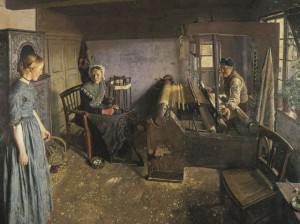 Bernard Winter, Die Webstube, 1896, Landesmuseum für Kunst und Kulturgeschichte Oldenburg, Postcard collection of Maggie Land Blanck, 2005 (used with permission)
Bernard Winter, Die Webstube, 1896, Landesmuseum für Kunst und Kulturgeschichte Oldenburg, Postcard collection of Maggie Land Blanck, 2005 (used with permission)
As a young lad, Dietrich was raised in the linen weaving trade. As linen weavers, they would have produced linens for such things as bedding, towels, tunics, shifts, and ship sails. The Schmidt family would have had a relatively small patch of land to farm, and every several years, they would have grown flax seed on their land to make linen out of. (They would not have been able to grow flax seed every year because it would have depleted the quality of the soil.)
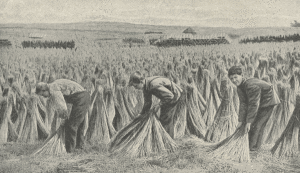 Flax Harvest, Collection of Maggie Land Blanck, 2011 (used with permission)
Flax Harvest, Collection of Maggie Land Blanck, 2011 (used with permission)
In July or August of their flax-growing year, they would have had to go out and pull the 2-to-3-feet-tall flax plants from the ground with the roots, and then tie them into bundles. They would have then had to ret the flax (which means soaking it in water to soften it and separate the fibers) for several weeks, probably in a nearby stream or pond, going out every so often to turn the flax bundles over. Afterward, they would have had to use a large “comb” to ripple the seeds away from the stems, and then they would have had to thrash the woody part of the flax plant away from the fibers.
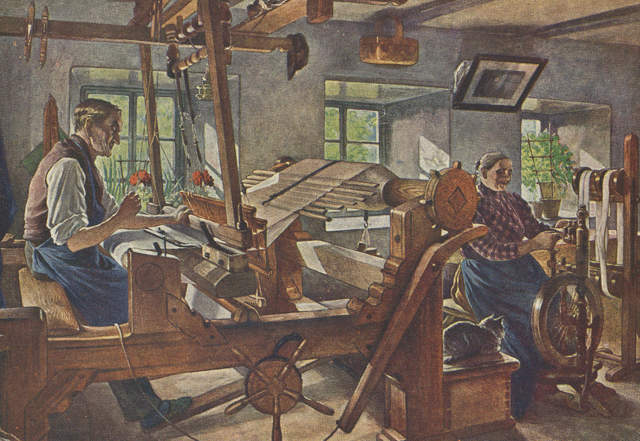 Linen Weavers, Postcard collection of Maggie Land Blanck, 2009 (used with permission)
Linen Weavers, Postcard collection of Maggie Land Blanck, 2009 (used with permission)
After separating out the longest and finest fibers of flax (these fibers were called “tow”), they would spin the “tow” into yarn and could then weave the yarn into linen cloth. Linen weaving was one of the oldest and most refined occupations in Germany. It was not a lucrative business for small, rural families by the time Dietrich Schmidt was engaged in it. It had been much more lucrative in the 1700s because of the large international demand for German linen in places like England and South America, but the various Revolutions and Napoleonic Wars disrupted international trade so badly that German linen exporters lost most of their foreign buyers. Much of the Schmidts’ linen was probably sold and used within their local area. As industrial machines started producing linen of better and better quality, it became increasingly difficult for rural hand-weavers to compete in the marketplace.
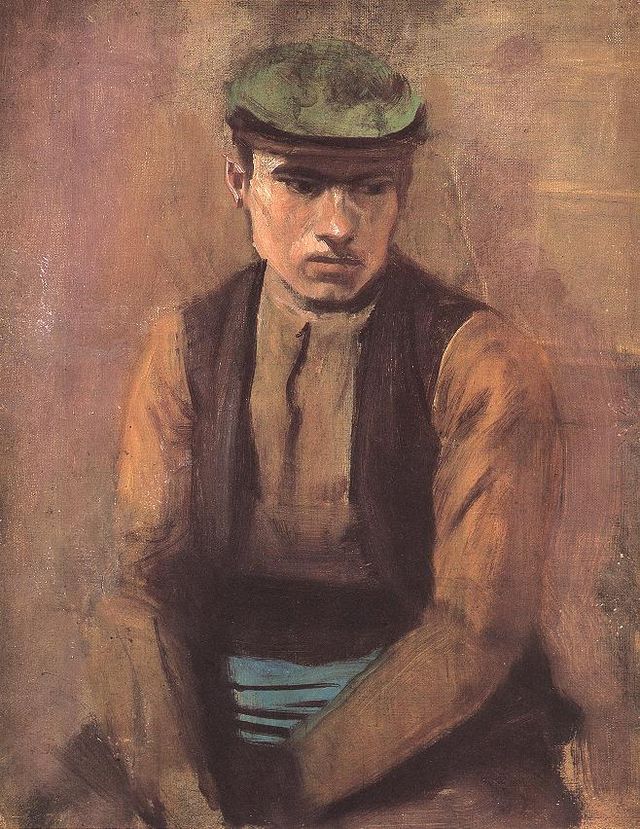 Day Laborer, by László Mednyánszky (1852–1919) (Wikimedia commons)
Day Laborer, by László Mednyánszky (1852–1919) (Wikimedia commons)
In order to supplement their income from linen weaving, the Schmidts were also engaged as Taglöhners (day laborers) and Teerführers (tar haulers). The woodland-covered part of Hesse where they lived was rife with mining activities. Many of the Schmidts made money by shoveling tar from the mines into wooden carts drawn by horses, and then hauling the tar where ever it needed to go. It would have been grueling physical labor. As day laborers, they would have worked the land for other farmers, and their pay would have been on a daily basis, with no guarantee that there would be work tomorrow. All this work would have been in addition to the small patches of land that each family would have been responsible for cultivating. Both linen weaving and manual laboring were very much lower class occupations. The Schmidt family would undoubtedly have been very poor. It was the ultimate dream of many German peasants to be able to own their own farm with lots of land, and this dream drew many such Germans to America throughout the 1800s.
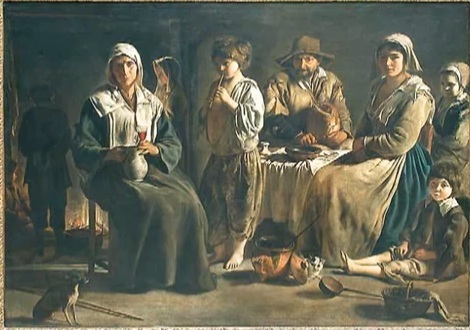 In early modern Europe, it wasn’t enough for a man and woman to agree to marry each other. Betrothal was a long, negotiated process that involved the entire family.
In early modern Europe, it wasn’t enough for a man and woman to agree to marry each other. Betrothal was a long, negotiated process that involved the entire family.
Above painting: Peasant Family in an Interior, Louis Le Nain (Wikimedia commons)
In 1822, as a 19-year-old young man, Dietrich’s difficulties were compounded when an 18-year-old girl in town became pregnant and it was revealed that he was the father. That young lady was Sophia Schmidt, Dietrich’s third cousin, daughter of Ludwig Schmidt and Dorothea Elisabeth (Raub) Schmidt. They may have already been promised to each other by their families, or they may have fallen in love with each other clandestinely. Regardless of how it started, the surprise pregnancy means that the two families would have had to immediately start marriage negotiations in earnest. In Germany in those days, marriage negotiations were a long, drawn-out process and could take years to complete before the couple would be able to tie the knot.
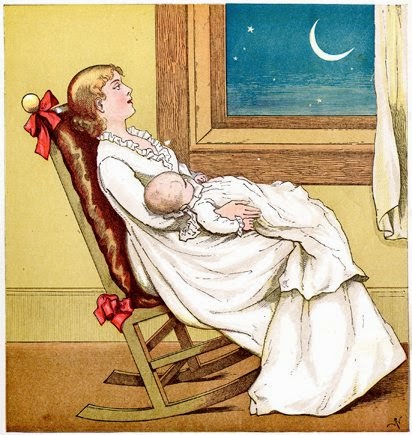 Young Mother with Child (Wikimedia commons)
Young Mother with Child (Wikimedia commons)
On the cold winter day of January 4th, 1823, Sophia Schmidt gave birth to a daughter, Anna Barbara Schmidt. As the families continued their negotiations, it would soon emerge that Sophia had become pregnant yet again. Eventually, a wedding date was set, and “bann” announcements were made in the local church proclaiming their upcoming nuptials (so that if anyone in town knew of a reason why Dietrich and Sophia shouldn’t be married, someone would have been able to speak up and say something before the wedding day).
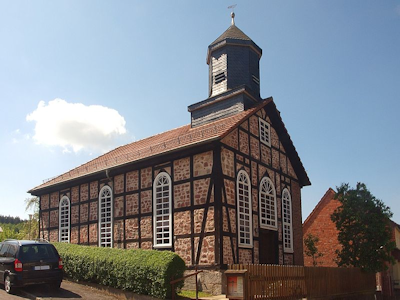 Village church of Machtlos, Germany (Wikimedia commons)
Village church of Machtlos, Germany (Wikimedia commons)
As the year progressed, it became clear that there was a race going on between Sophia’s due date, and Dietrich and Sophia’s wedding date. Sophia’s due date ended up winning, with Sophia giving birth to a second daughter, Anna Sabine Schmidt, on April 23rd, 1825, just one day before Dietrich and Sophia’s wedding. Although pregnancy before marriage, and even childbirth before marriage, were not uncommon in the poor rural villages in this part of Hesse, it was still a frowned-upon matter. Dietrich and Sophia’s wedding would have certainly been a subdued, sober event, heralded with very little pomp or celebration. The Schmidt family home was divided up, and Dietrich and Sophia Schmidt were allotted part of House #6 to live in and raise their new family in.
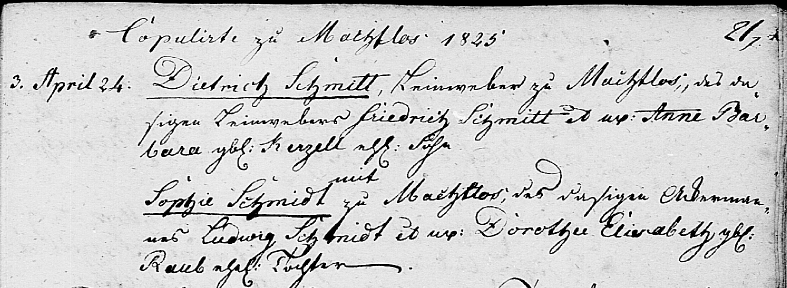 Dietrich Schmidt and Sophia Schmidt marriage record, 24 April 1825, Machtlos
Dietrich Schmidt and Sophia Schmidt marriage record, 24 April 1825, Machtlos
Dietrich and Sophia Schmidt went on to have 8 more children, eventually making a grand total of 10. They were:
- Anna Barbara Schmidt, born 4 January 1823, married Jakob Bohn of Imshausen
- Anna Sabine Schmidt, born 23 April 1825, married Georg Sieling of Pfieffe
- Anna Martha Schmidt, born 11 July 1827, married Johannes Rimbach of Blankenbach
- Anna Elisabeth Schmidt, born 12 June 1830, married Conrad Leimbach of Machtlos
- Dietrich Schmidt II, born 20 January 1833, married Martha Elisabeth Lindemann (daughter of Conrad Lindemann) of Machtlos
- Balthasar Ludwig “Louis” Schmidt, born 4 August 1835, married Amelia Barbara Heimerdinger of Baltimore
- Martha Catharina Schmidt, born 11 September 1837, married Philip William H. Busch of Boston
- Herman Schmidt, born 20 April 1840, married Catharine C. Vogel of Dorzbach
- Conrad Jacob Schmidt, born 21 December 1841, married Martha Elisabeth Lindemann (daughter of Johannes Lindemann) of Machtlos
- Friedrich Schmidt, born 16 June 1844, first married Friederike Beckmann, and then married Catharine Schneider of Burkhards
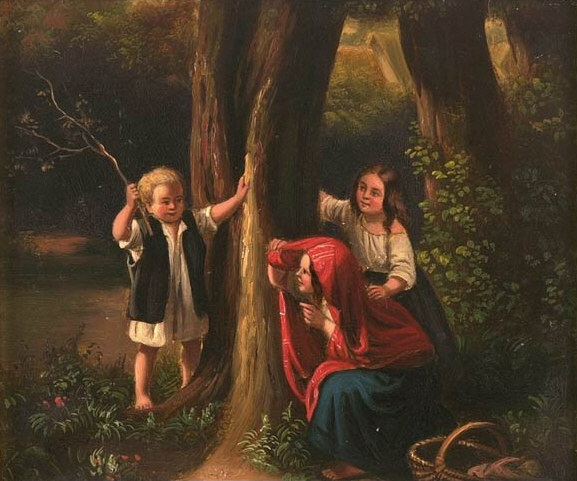 Three Children Playing Hide & Seek in a Forest, Friedrich Eduard Meyerheim (1808-1879) (Wikimedia commons)
Three Children Playing Hide & Seek in a Forest, Friedrich Eduard Meyerheim (1808-1879) (Wikimedia commons)
Virtually all poor, lower-class families in German villages tended to lose at least one child to disease, malnutrition, or accident. Many families lost multiple children, and some unlucky families were unable to keep even one of their children alive into adulthood. In a rather uncommon feat, Dietrich and Sophia Schmidt managed to raise 10 healthy children to adulthood, an accomplishment that would have surely been a point of pride for them in their later years.
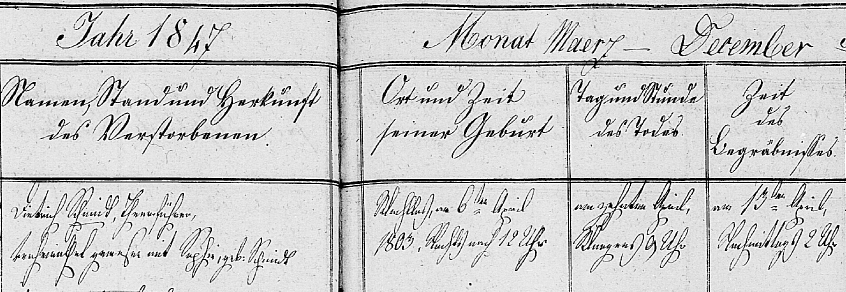 Dietrich Schmidt death & burial record, 10 April 1847, Machtlos
Dietrich Schmidt death & burial record, 10 April 1847, Machtlos
Although Dietrich’s industriousness had paid off by keeping an enormous family alive and healthy, his lifetime of difficult physical work had taken its toll on him, and he died on April 10th, 1847, at the age of 44.
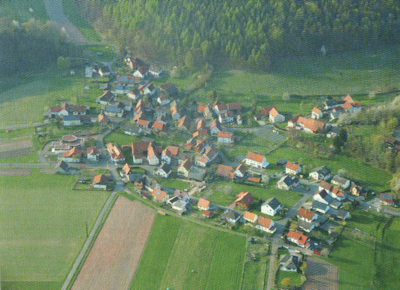 Machtlos, now a borough of Ronshausen
Machtlos, now a borough of Ronshausen
(Image Source: Mueller, Heinrich Georg. 950 Jahre Ronshausen Leben in Unserem Dorf; Gestern, Heute, Morgen; Festschrift Anlasslich Der Jubilaumsfeierlichkeiten Im Jahr 2011. Ronshausen: Vereinsgemeinschaft 950 Jahre Ronshausen, 2011. p.274.)
The hard-earned savings he left behind for his family, and the attitude of sufficiency and enterprise that he instilled in his children, clearly were significant: 5 out of his 10 children went on to immigrate to America and make quite good lives for themselves. In fact, the Dietrich and Sophia Schmidt family saw more children immigrate to America than any other household in the town of Machtlos.
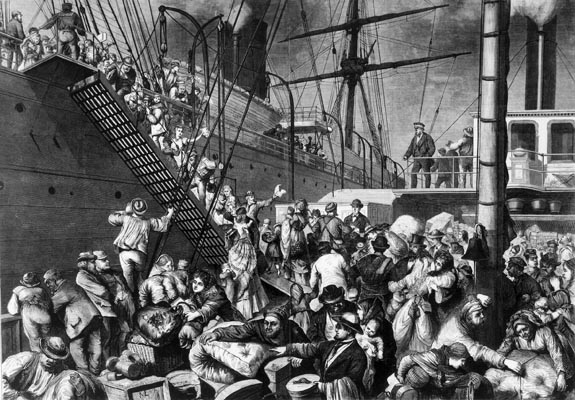 German Emigrants Headed for New York Board a Steamer in Hamburg Germany (Collection of the Lower East Side Tenement Museum) (Wikimedia Commons)
German Emigrants Headed for New York Board a Steamer in Hamburg Germany (Collection of the Lower East Side Tenement Museum) (Wikimedia Commons)
Their daughter, Anna Martha “Hannah” Schmidt was the first to leave Germany, in 1850. She settled in Boston where she married the shoemaker Johannes “John” Rimbach and had several children. As they made money, she sent some back to her family so that her younger brother Balthasar Ludwig “Louis” Schmidt could come to America also. He did so in 1853, eventually becoming a successful restaurateur in Washington DC. The sister and brother then sent for their sister Martha Catharina Schmidt to join them in America in 1855. She settled in Boston and married Philip William H. Busch, a shoemaker who went on to run his own shoe store. In 1857, the siblings helped their younger brother Herman Schmidt immigrate to America, and–after serving in the Union Army during the Civil War–Herman became a restaurateur, salesman, and boarding house manager in Washington DC. Lastly, their second youngest brother, Conrad Jacob Schmidt, brought his family to America much later, in 1883, settling in Dysart, Iowa and ultimately on a farm in West Bend, Iowa.
 Sophia (Schmidt) Schmidt death & burial record, 21 May 1857, Machtlos
Sophia (Schmidt) Schmidt death & burial record, 21 May 1857, Machtlos
On May 21st, 1857, around the time that Dietrich and Sophia Schmidt’s son Herman was embarking on his voyage to America, the widow Sophia Schmidt died at her home in Machtlos. Having raised a houseful of happy, healthy, successful children with the help of her honest, tirelessly hard working husband, she surely had much to be thankful for.
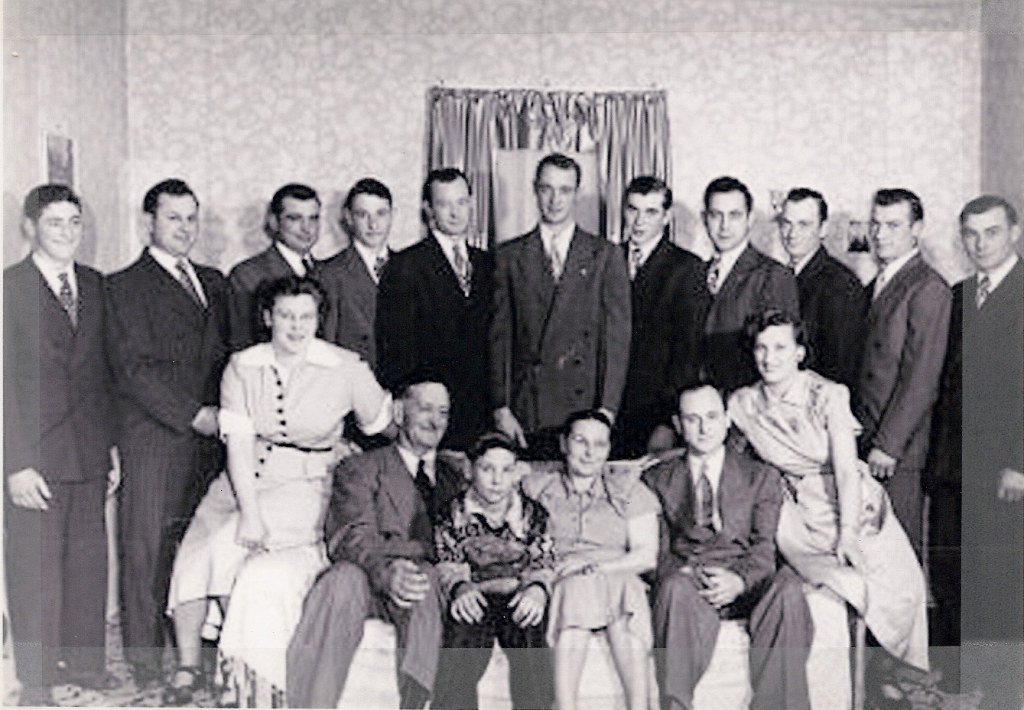 Fred and Emma (Messner) Schmidt with their 15 children in West Bend, Iowa
Fred and Emma (Messner) Schmidt with their 15 children in West Bend, Iowa
One of the many large Schmidt families in America that descend from Dietrich Schmidt of Machtlos, Germany
(Photo courtesy of Linda Swalin)
As the father of virtually everyone in America who can trace their ancestry to the town of Machtlos and bears the surname “Schmidt”, we remember and are grateful to Dietrich Schmidt for the sacrifices he made. All of the health, happiness, and success that each of us have achieved is due in some part to the long, sunrise-to-sundown days of hard labor that Dietrich Schmidt worked in a poor, obscure hamlet in Germany two hundred years ago. Happy Father’s Day to our ancestor, Dietrich Schmidt, and to all the dads in the Schmidt family.
Reconnect with fellow descendants of the Machtlos Schmidt family on July 30-31, 2016, at the world-record-breaking Schmidt Family Reunion in Spencer, Iowa! RSVP now!

Excellent story about the Schmidt family….. do wish that my kinfolk of the 1800’s had provided enough information that something like the above could have been written.
When we started this research, we never thought this much information would be able to be culled, but you would be surprised when you keep doggedly working at it and scraping out every last detail that you can. Even if you can no longer find out more facts about your ancestor in particular, you can get a richer picture of their life by studying the general characteristics of the time and place that your ancestor lived in.